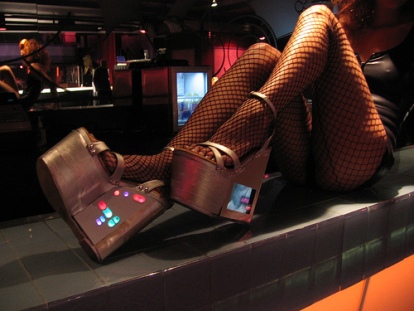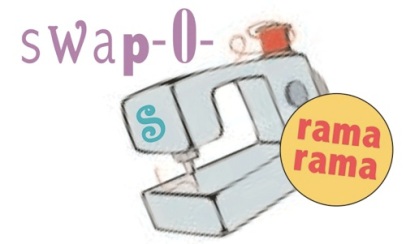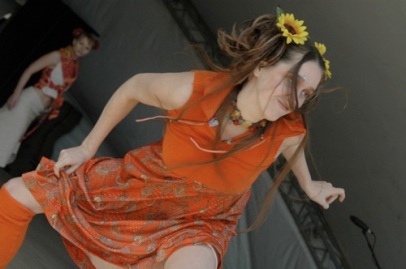A little background on  (through their web-site)>
(through their web-site)>
Since 2001, OFFF is exploring software aesthetics and new languages for interactive and visual expression.
Every year, the festival features digital artists, web and print designers, motion graphic studios and avant-garde electronic musicians. But OFFF is more than an event about any of these disciplines. More than a design conference, a multimedia trade fair, or a digital animation festival. OFFF is an enthusiastic celebration of a new visual culture.
OFFF is spreading the work of a generation of creators that are breaking all kind of limits. Those separating the commercial arena from the worlds of art and design; music from illustration, or ink and chalk from pixels. Artists that have grown with the web and receive inspiration from digital tools, even when their canvas is not the screen.
From exercises in interactive synesthesia that excite all our senses to stage performances made of lines of computer code. All this, and much more, is shown every year at OFFF; one of the essential meeting points for the international scene of postdigital creation.
Past participants in OFFF include legends of graphic design and visual communication like Neville Brody, Tomato, Kyle Cooper or Stefan Sagmeister; acknowledged software artistssuch as Jared Tarbell, Lia, Casey Reas y Ben Fry, or Daniel Brown; innovators of the moving image like We work for Them, Tronic Studio, D-Fuse or Renascent; explorers of advanced interaction like Soda, James Paterson, Amit Pitaru or Craig Swann; and the most important names that have defined the aesthetics of the experimental and creative side of the Web: Joshua Davis, Yugo Nakamura, Hi-Res!, Josh Ulm, or Erik Natzke. The festival has also a special spot for the main names in the Spanish scene (Area3, Vasava, Innothna, Cocoe, Dani Granatta, La Mosca…) and for creators of surprising new kinds of sonic landscapes: Tujiko Noriko, The Vegetable Orchestra, Sutekh, Taylor Deupree, System, Daedelus, Stephan Mathieu, Kenneth Kirschner…
________________________
Coverage by, (who else ?!) Regine
On the last day at OFFF in Barcelona, Matt Pyke gave a little walk-through of his work at the Designers Republic and especially all the things he has been setting up (from a lovely garden in Sheffield) with his multidisciplinary studio Universal Everything since he has left there.

Especially nice were the 20.000 generated characters for the Lovebytes festival which instantly became the subject of collecting and their installations for the Nokia store in NYC. On its screens you see people which are basically flocks of pixels which interchange parts of each other when calling – creating a simple yet poetic visualization of the company’s “connecting people”-mantra. They also have a blog called Everyone Forever on which Universal Everything collect stuff that inspires them.
Later that day, it was John Maeda’s turn which put me in a similar position to Régine when Bruce Sterling was talking at IFID since it was more of an eclectic lecture to inspire his numerous audience which is naturally difficult to write up. We’ll try anyway:
Actually, John Maeda never wanted to talk about his work in front of audiences like this again ever since an illustrator told him that his computer-based work “is so empty”. It’s much better to talk about ideas anyway. One of his latest ideas was Simplicity but he’s already getting tired of that by now. When he got really tired, he went on a vacation at Cape Cod, Massachusetts. He needed to get khaki shorts, so he went to a GAP store and there was even more simplicity (“Keep it simple”), switch on the TV and you see Paris Hilton living “The Simple Life” and the list goes on. But maybe we just love complexity too much to make everything simple. Take the MIT media lab, a place which, thanks to I.M. Pei‘s architecture, looks very simple from the outside. Yet, it’s a very complex place. While at Google, you get free smoothies (and accumulate the dreaded Google 15), in academia there’s no such thing. Instead they give people titles, lots of them, making their lives ever more complex with growing responsibilities. As he also describes in his book Maeda@Media, John grew up in a family-run tofu factory in Seattle. Tofu also is simple food, but the edamame beans it is made of need to go through a complex process to become the final product. This was a very spartan education and made him thoroughly enjoy studying at school. When it was time to choose a college, he went for MIT’s media lab, which, from above, coincidentally also resembles a chunk of tofu. He met Muriel Cooper who told him to go to art school which is what he did and where he met more mentors like Paul Rand and Ikko Tanaka who were all very advanced in their careers and focussed more on humanizing their students than anything else.

John Maeda (sort of) and his Apple II
Early in John’s own professional career, Japanese cosmetics-company Shiseido had him working “like Batman, teaching by day, arting by night”. Yet, many would consider his work to be “eye candy”, a term which he would like to see replaced with “eye meat” since it tries to get to the core of the question about how to create with computers. Back in those days, Maeda got an Apple 2-computer for $1500 and it did nothing. In 1995 in Kyoto, he built the “Human Powered Computer” which replaced all the mysterious inner workings of the machine with people. Quite funny and it lead him to better understand the spirituality of the machine. Many said that “the computer is nothing more that a pencil”, a statement which made many designers and artists feel comfortable with great changes already on the horizon. It is indeed a great tool, but we’re still trying to find out what kind of tool it really is. Every today’s software works a bit like a tree with alternatives branching out everywhere. Problem is, when you try to make art you always get stuck on that tree. And: paradoxically, true art will always be off that tree entirely.
Read full article here >
Coverage by Regine >
Filed under: architecture, art, DIY, films, graphics, hack, locative, mobility, new media, physical computing, research, social, space/place, technology, urban
































